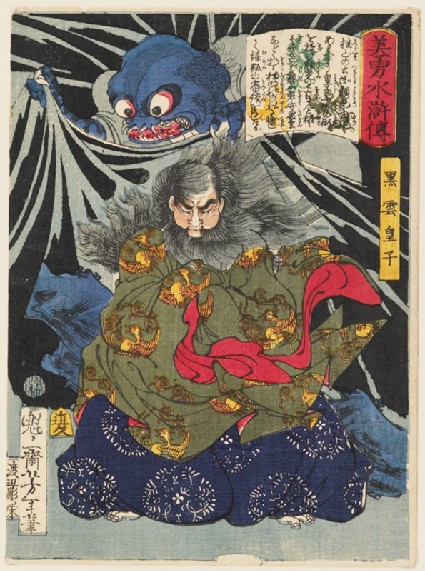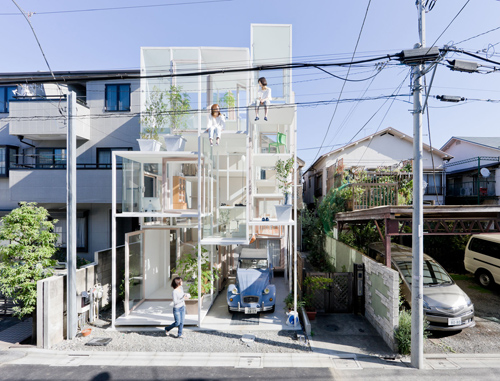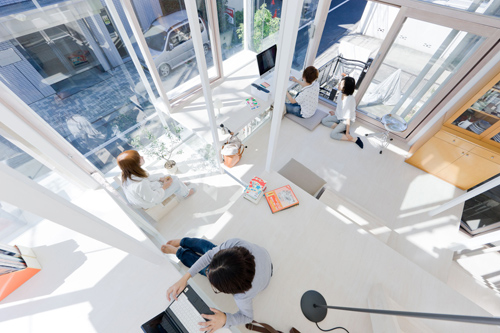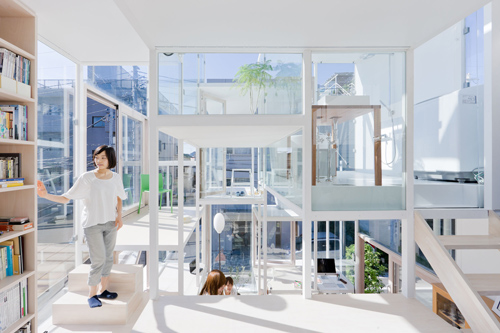By MIWA MURPHY
Kyodo
BOSTON — Among the more than 100 pieces of art displayed in New York's Rockefeller Center by figures such as Diego Rivera, Isamu Noguchi and Lee Lawrie, mostly from the 1930s and 1940s, a glowing piece named "Light and Movement" by a Japanese-American artist blends into its surroundings, despite its size.
Which is exactly what its creator intended.
"My goal is always for the art to integrate successfully with the architecture," Michio Ihara said in a recent interview at his home-cum-studio in Concord, Massachusetts, near Boston.
The 83-year-old, who describes himself as an architectural sculptor, implies his hobby is work, or vice versa. He creates artistic structures both small and large, including the 3-ton "Wind Wind Wind," which was installed in central Boston earlier this year.
"When the sun shines on this, it creates a very good effect," Ihara said, looking up at the 8-meter-tall structure made with about 200 sheets of kinetic stainless steel.
This new installation and the 1978 wall sculpture at Rockefeller Center are only part of his large collection of works that decorate various buildings and public spaces not only across the United States, but also in cities around the world, including Tokyo, Hong Kong, Singapore and Auckland.
Born in Paris in 1928 to a painter father who was on a trainee program to study Western art and an accomplished pianist mother, Ihara returned to Japan with his parents the following year, settling down in Tokyo's Setagaya Ward.
Ihara said he was an "ordinary middle school kid" during World War II, just barely young enough to avoid being drafted. He spent much of the final year of the war recovering from a pneumonialike condition brought on by malnutrition and damp bomb shelter air.
The eldest of four children, Ihara said he tried to become a painter soon after the war just as "a carpenter's son becomes a carpenter."
But by the time he completed four years of study of European oil painting at the predecessor to Tokyo University of the Arts in the early 1950s, he knew the craft was not his calling.
"I began to look for my own direction. . . . Like any young graduate thrown into the real world for the first time, I was trying to establish myself, and the only way to do so was to find my own field, like finding a narrow crack in the wall," he said.
Ihara said his lifelong fascination with architectural space started around this time, even though he was not clearly conscious of it. He created an experimental group focused on stage design with a few budding artists. "There is an organic connection — playwrights, audience, performers and the stage."
Ihara then attended a lecture hosted by art critic Kazuhiko Egawa, who introduced him to the art theory of Hungarian painter Gyoergy Kepes.
Egawa talked about a light mural Kepes installed at Manhattan's KLM building, stirring Ihara's interest in new architecture. The Japanese landscape at the time, after all, was "not that far from a bombed-out field," Ihara said.
Inspired, Ihara applied for a Fulbright scholarship in 1959 to study mural art in the U.S.
To his surprise, Kepes, who was teaching at the Department of Architecture at Massachusetts Institute of Technology at the time, invited the young Ihara to come to study with him, even though his grant was intended for the art category.
"That was a turning point in my life," Ihara said.
After one year at MIT, Ihara was hired by the university as a research associate. As he broadened his artistic horizons, work started to flow in, including a 1963 commission to create and install a wall sculpture in an office building in the Massachusetts city of Waltham.
With the expiration of his visa, Ihara returned to Japan in 1964. He continued to get commissions in the Tokyo area and also taught three years at Musashino Art University's newly established Department of Architecture. At the same time, Japan's postwar economic growth kicked off, with a milestone reached at the 1970 World Expo in Osaka Prefecture.
While Ihara kept himself busy with the expo-related work, the "megasize experience" also felt to him like a "bubble inflated beyond Japan's actual scale," he recalled. He also began to feel fatigued about the cliquish culture in Japan's art world, with its heavy emphasis on personal connections.
As he was repeatedly called by Kepes to join his newly established Center for Advanced Visual Studies at MIT as a fellow, Ihara decided to move to the United States in 1970. The Hungarian pioneer of visual design became a lifelong family friend.
Ihara got the Rockefeller Center commission through a New York art agent, George Staempfli, who ran a Manhattan gallery known for a variety of European and American paintings as well as sculpture.
"His refined taste reflects that persistent Japanese craving for the cleanest possible design, for the simplest possible functional form of any given object," Staempfli wrote of Ihara's works in 1984.
Asked if traditional Japanese designs inspire him, Ihara said he has "always consciously tried not to bring Japan to the surface" of his mind, so if viewers detect Japan in his works, it is only because it exists in him "naturally."
Even after spending nearly 50 years in the United States, Ihara says he is still as Japanese as he has ever been.
"There is no problem to keep heritage alive because it's within."









